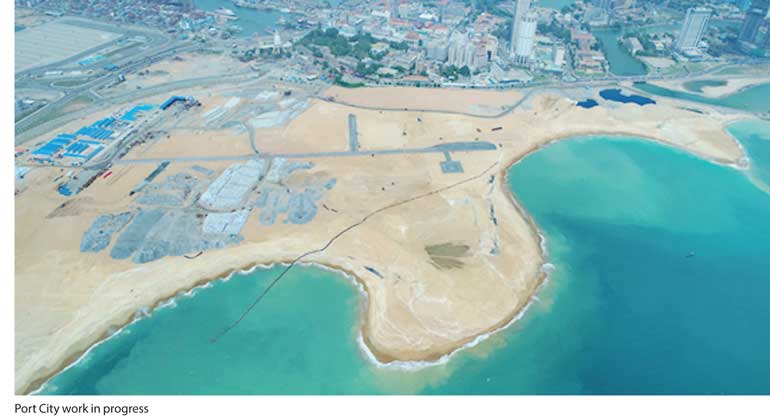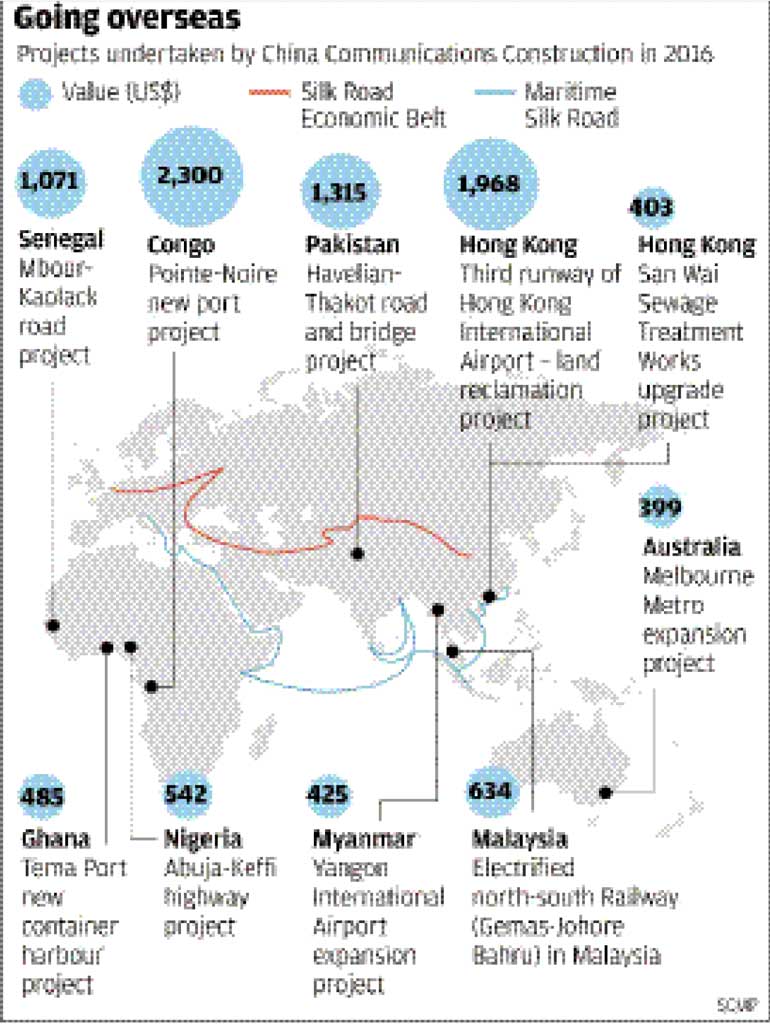Friday Apr 18, 2025
Friday Apr 18, 2025
Wednesday, 17 May 2017 00:00 - - {{hitsCtrl.values.hits}}

www.scmp.com: China is building a new city along Colombo’s coastline that will become the city’s central business district by  2030, creating 80,000 jobs for Sri Lankans, under the mainland’s ‘Belt and Road Initiative’.
2030, creating 80,000 jobs for Sri Lankans, under the mainland’s ‘Belt and Road Initiative’.
“Sri Lanka is in urgent need of a high-end platform to attract financial institutions, multinational companies, shoppers, tourists as well as provide jobs for well-educated locals as a part of its post-war reconstruction. The Port City project is planned in the best interests of Sri Lanka,” said China Communications Construction Company (CCCC) Vice President Sun Ziyu in an interview with the South China Morning Post.
With an initial investment of $ 1.4 billion, the Colombo Port City is China’s biggest project in Sri Lanka, a key node along the Maritime Silk Road of the Belt and Road plan.
Sun said the development within Sri Lanka’s biggest commercial city, which will be built on 269 hectares of reclaimed land, will accommodate 200,000 residents and consists of apartments, hotels, offices, shopping malls, exhibition centres as well as provide 80,000 new jobs. It is expected to be completed by 2030.
Sun said the reclamation work had helped transform the area’s coastline which was previously hit by strong winds blowing towards the Indian Ocean that made it less livable.
“[This has] also improved coastal protection, and is a boon to the environment,” he said.
China’s ‘Belt and Road’ plan comprises a belt of overland corridors and sea routes connecting Asia, Africa and Europe through building infrastructure and boosting financial and trade ties for over 60 countries that lie along the routes.
In 2016 alone, Chinese firms signed new construction projects worth a total contractual value of $ 126 billion. CCCC accounted for one-tenth or $ 12.6 billion of the projects.
It has participated in more than 300 Belt and Road projects across 58 countries. Key projects include the China-Pakistan Economic Corridor, Zemun-Borca Bridge in Serbia and the North-South Highway in Jamaica, with a value totaling $ 47 billion.
Even with numerous years of overseas experience behind them, Sun said each investment decision was made on repeated verification on multiple fronts of the prospects – from local culture, regulatory policies to environmental issues, as well as soliciting advice from world-class experts. The most important measurement is, the project must benefit local society, he said.
“Making profit is important, but if you only consider making money, you will finally lose it. Benefiting others, you will benefit at the end,” Sun stressed.
In Kenya, the company has helped build its first new railway in over 100 years that will begin operations next month. The 480-kilometre track, which replaces the abandoned British-built track, connects the capital Nairobi with East Africa’s largest port of Mombasa. The $ 4 billion construction is also the biggest infrastructure project in Kenya since its independence in 1963.
Sun said the Belt and Road was an open-ended platform and the Chinese way is not the only standard.
Take the railway project. The company was unable to lay the standard Chinese tracks on the black cotton soil in Africa, but had to make adjustments to accommodate local conditions.
To date, CCCC has expanded its footprint in over 140 countries and regions, with major overseas business in Africa, South-east Asia, Oceania, Middle East and Eurasia.
In 2016, new contracts for overseas infrastructure construction signed amounted to 205.9 billion yuan ($ 29.8 billion), a 51% increase over the previous year. It has also ventured into Italy and Canada for the first time in 2016, and looks to expand in Europe next, as well as the US.
The company’s net profit climbed 8.7% to 17.2 billion yuan in 2016. Revenue gained 6.5% to 429.97 billion yuan, helped by a 16% increase in overseas revenue, which outpaced its domestic sales growth of 5%. Overseas business accounted for a fifth of the company’s revenue last year.

Discover Kapruka, the leading online shopping platform in Sri Lanka, where you can conveniently send Gifts and Flowers to your loved ones for any event including Valentine ’s Day. Explore a wide range of popular Shopping Categories on Kapruka, including Toys, Groceries, Electronics, Birthday Cakes, Fruits, Chocolates, Flower Bouquets, Clothing, Watches, Lingerie, Gift Sets and Jewellery. Also if you’re interested in selling with Kapruka, Partner Central by Kapruka is the best solution to start with. Moreover, through Kapruka Global Shop, you can also enjoy the convenience of purchasing products from renowned platforms like Amazon and eBay and have them delivered to Sri Lanka.
Discover Kapruka, the leading online shopping platform in Sri Lanka, where you can conveniently send Gifts and Flowers to your loved ones for any event including Valentine ’s Day. Explore a wide range of popular Shopping Categories on Kapruka, including Toys, Groceries, Electronics, Birthday Cakes, Fruits, Chocolates, Flower Bouquets, Clothing, Watches, Lingerie, Gift Sets and Jewellery. Also if you’re interested in selling with Kapruka, Partner Central by Kapruka is the best solution to start with. Moreover, through Kapruka Global Shop, you can also enjoy the convenience of purchasing products from renowned platforms like Amazon and eBay and have them delivered to Sri Lanka.